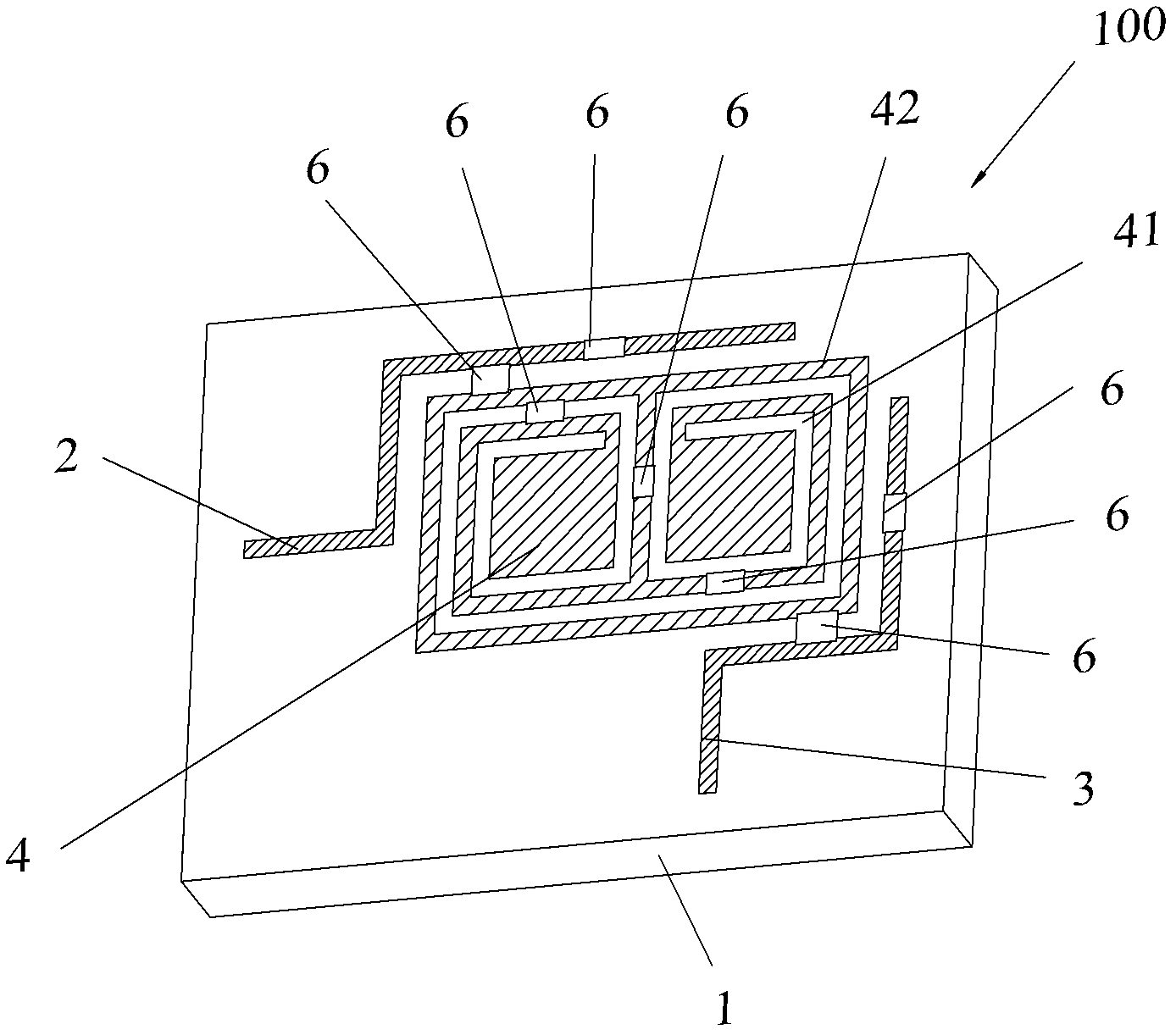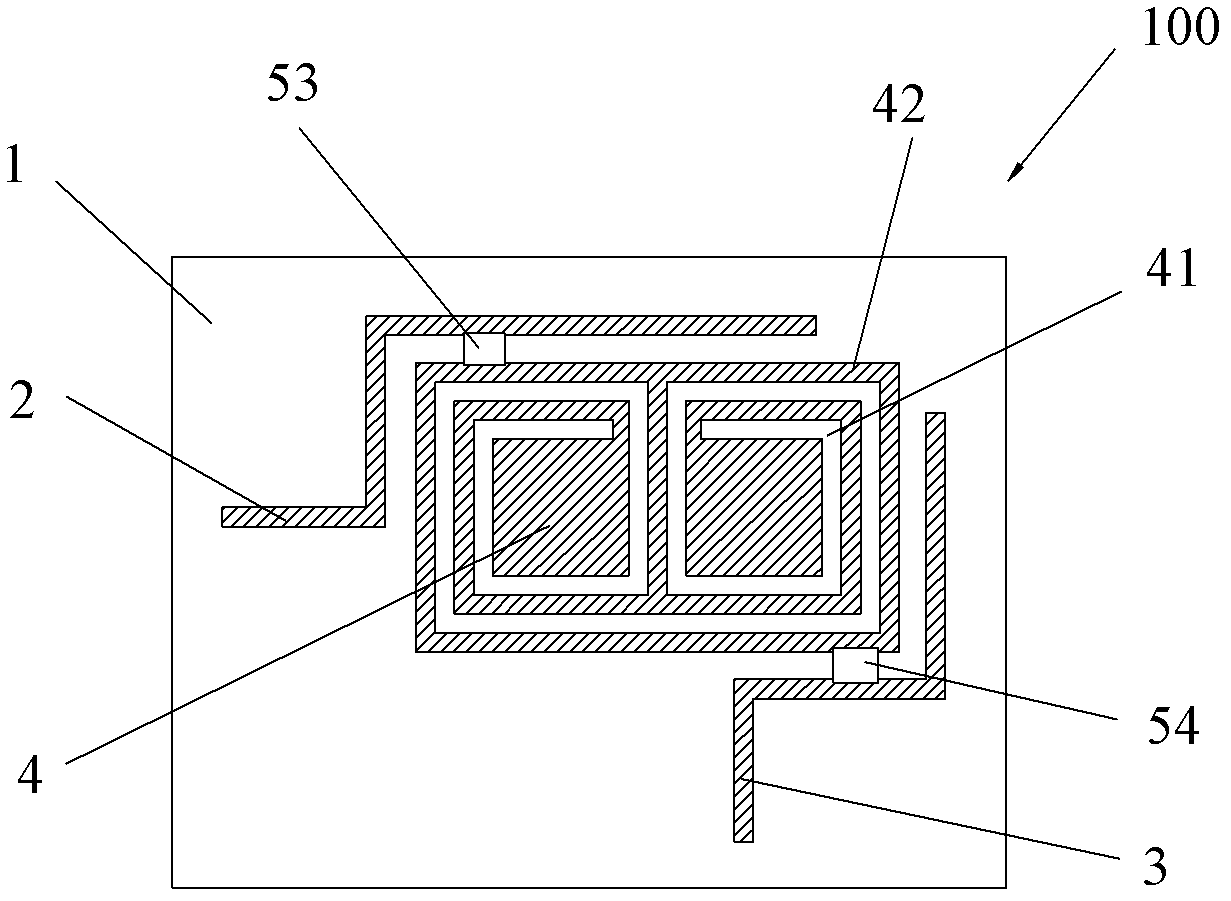Reader-writer, electronic tag and radio frequency identification system
An electronic tag, radio frequency identification technology, applied in the field of readers, electronic tags and radio frequency identification systems, can solve the problems of versatility, performance differences, antenna performance differences, etc.
- Summary
- Abstract
- Description
- Claims
- Application Information
AI Technical Summary
Problems solved by technology
Method used
Image
Examples
Embodiment 2
[0047] Such as image 3 As shown, in this embodiment, between the first feeder line 2 and the metal sheet 4, and between the second feeder line 3 and the metal sheet 4, a space 53, and a space 54 for embedding capacitive electronic components are preset. The position of the electronic component space can be any position between the first feeder 2 and the metal sheet 4 and between the second feeder 3 and the metal sheet 4. image 3 The middle space 53 and the space 54 are the spaces where capacitive electronic components are embedded in this embodiment. There is a certain capacitance between the first feeder line 2, the second feeder line 3 and the metal sheet 4, and the first The signal coupling between the feeder 2, the second feeder 3 and the metal sheet 4, using the formula: It can be seen that the size of the capacitance value is inversely proportional to the square of the operating frequency, so when the required operating frequency is a lower operating frequency, it can be...
Embodiment 3
[0049] Such as Figure 4 As shown, in this embodiment, a space for embedding inductive electronic components and / or resistors is reserved on the metal trace 42 of the metal sheet, and the space for embedding electronic components is not limited to the space 55 and the space given in the figure. 56, other locations as long as the conditions are met. The purpose of embedding inductive electronic components here is to increase the inductance value of the internal resonant structure of the metal sheet, thereby adjusting the resonant frequency and working bandwidth of the antenna; as in the first embodiment, the purpose of embedding resistors here is to improve the antenna’s Radiation resistance. As for whether to embed inductive electronic components or resistors, it depends on the needs. In addition, in the space where electronic components are not embedded, wire shorting is used.
Embodiment 4
[0051] Such as Figure 5 As shown, in this embodiment, a space 57 for embedding capacitive electronic components is reserved on the microgroove structure 41, and the space 57 is connected to the metal traces 42 on both sides of the microgroove structure 41. The space for embedding electronic components is not limited to Figure 5 The space 57 given in, other locations as long as they meet the conditions. Embedding capacitive electronic components can change the resonance performance of the metal sheet, and ultimately improve the Q value and resonance operating point of the antenna. As common knowledge, we know that the relationship between the passband BW and the resonant frequency w0 and the quality factor Q is: BW=wo / Q. This formula shows that the larger the Q, the narrower the passband, and the smaller the Q, the wider the passband. In addition: Q = wL / R = 1 / wRC, where Q is the quality factor; w is the power supply frequency when the circuit is resonant; L is the inductance;...
PUM
 Login to View More
Login to View More Abstract
Description
Claims
Application Information
 Login to View More
Login to View More - R&D
- Intellectual Property
- Life Sciences
- Materials
- Tech Scout
- Unparalleled Data Quality
- Higher Quality Content
- 60% Fewer Hallucinations
Browse by: Latest US Patents, China's latest patents, Technical Efficacy Thesaurus, Application Domain, Technology Topic, Popular Technical Reports.
© 2025 PatSnap. All rights reserved.Legal|Privacy policy|Modern Slavery Act Transparency Statement|Sitemap|About US| Contact US: help@patsnap.com



